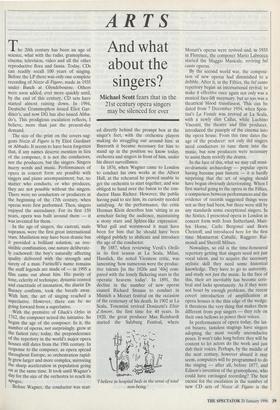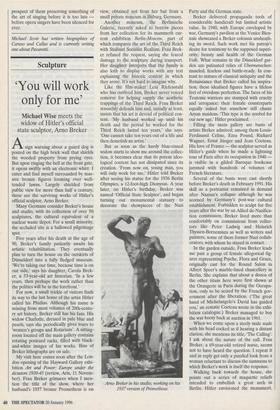ARTS
And what about the singers?
Michael Scott fears that in the 21st century opera singers may be silenced for ever
The 20th century has been an age of science, what with the radio, gramophone, cinema, television, video and all the other reproductive flora and fauna. Today, CDs can readily recall 100 years of singing. Before the LP there was only one complete recording of Nozze di Figaro, made in 1935 under Busch at Glyndebourne. Others were soon added, ever more quickly until, by the end of this century, CD sets have started almost raining down. In 1994, Deutsche Grammophon issued Eliot Gar- diner's, and now DG has also issued Abba- do's. This prodigious escalation reflects, I believe, more than just the present-day demand.
The size of the print on the covers sug- gests Nozze di Figaro is by Eliot Gardiner or Abbado. It seems to have been forgotten that, if any names deserve mention in lieu of the composer, it is not the conductors, nor the producers, but the singers. Singers marry words and music. Performances of opera in concert form are possible with singers and piano accompaniment; but, no matter who conducts, or who produces, they are not possible without the singers. There were no conductors or producers at the beginning of the 17th century, when operas were first performed. Then, singers enjoyed the ascendancy. For its first 150 years, opera was built around them — it was invented for them.
In the age of singers, the castrati, male sopranos, were the first great international stars. Mutilation may have been drastic but it provided a brilliant solution, an irre- sistible combination, one nature deliberate- ly eschewed: the boy's naturally affecting quality delivered with the strength and surety of a man. Farinelli's name remains the stuff legends are made of — in 1995 a film came out about him. His purity of tone, celerity of technique, dynamic control and exactitude of intonation, the diarist Dr Burney confirms, took the breath away. With him, the art of singing reached a superlative. However, there can be no going forward from a superlative.
With the premiere of Gluck's Orfeo in 1762, the composer seized the initiative. So began the age of the composer. In it, the number of operas, not surprisingly, grew at the fastest rate; today, the preponderence of the repertory in the world's major opera houses still dates from the 19th century. In response to the composer, as opera spread throughout Europe, so orchestration rapid- ly grew larger and more complex, mirroring the sharp acceleration in population going on at the same time. It took until Wagner's day for the size of the orchestra to reach its apogee.
Before Wagner, the conductor was seat- ed directly behind the prompt box at the singer's feet, with the orchestra players making do straggling out around him: at Bayreuth it became necessary for him to stand up in the position we know today, orchestra and singers in front of him, under his direct surveillance.
In 1876, when Wagner came to London to conduct his own works at the Albert Hall, at the rehearsal he proved unable to get the orchestra to start together, and was obliged to hand over the baton to the con- ductor Hans Richter. However, the public having paid to see him, its curiosity needed satisfying. At the performance, the critic Herman Klein describes him 'sitting in an armchair facing the audience, maintaining a stony stare and Sphinx-like expression'. What gall and wormwood it must have been for him that he should have been obliged publicly to abdicate and introduce the age of the conductor.
By 1887, when reviewing Verdi's Otello in its first season at La Scala, Milan, Hanslick, the noted Viennese critic, was lamenting 'how numerous were the produc- tive talents [in the 1820s and '40s] com- pared with the lonely flickering stars in the operatic heavens today'. In 1891, the decline in the number of new operas caused Richard Strauss to conduct in Munich a Mozart festival on the occasion of the centenary of his death. In 1902 at La Scala, Toscanini revived Donizetti's Elisir d'Amore, the first time for 40 years. In 1920, the great producer Max Reinhardt started the Salzburg Festival, where `I believe in hospital beds in the sense of total non-being.' Mozart's operas were revived and, in 1933 in Florence, the composer Mario Labrocca started the Maggio Musicale, reviving bel canto operas.
By the second world war, the composi- tion of new operas had diminished to a dribble. After it, in the Fifties, the bel canto repertory began an international revival; to make it effective once again not only was a musical face-lift necessary, but so too was a theatrical blood transfusion. This can be dated from 7 December 1954, when Spon- tini's La Vestale was revived at La Scala, with a newly slim Callas, while Luchino Visconti, the theatre and film producer, introduced the panoply of the cinema into the opera house. From this time dates the age of the producer: not only did singers need conductors to tune them into the music, but now producers were necessary to assist them revivify the drama.
In the face of this, what we may call musi- co-dramatic archaeology — popular opera having become past historic — it is hardly surprising that the art of singing should have begun obviously deteriorating. When I first started going to the opera in the Fifties, a comparison between performances and the evidence of records suggested things were not as they had been, but there were still by any standards some exceptional singers. In the Sixties, I presented opera in London in concert form with Joan Sutherland, Mari- lyn Home, Carlo Bergonzi and Boris Christoff, and introduced here for the first time Montserrat Caballe, Ruggero Rai- mondi and Sherrill Milnes.
Nowadays, so old is the time-honoured repertory getting that singers need not just vocal talent, and to acquire the necessary stylistic skill they need some historical knowledge. They have to go to university, and study not just the music. In the face of this, their art inevitably has become cere- bral and lacks spontaneity. As if they were not beset by enough problems, the recent covert introduction of amplification at opera houses is the thin edge of the wedge; it threatens the very thing that makes them different from pop singers — they rely on their own bellows to power their voices.
In performances of opera today, the lat- est bizarre, tasteless stagings have singers adopting the most vocally unconducive poses. It won't take long before they will be content to let actors do the work and just dub their voices. Perhaps, by the middle of the next century, however absurd it may seem, computers will be programmed to do the singing — after all, before 1877, and Edison's invention of the gramophone, who could have envisaged recording? The best excuse for the escalation in the number of new CD sets of Nozze di Figaro is the prospect of them preserving something of the art of singing before it is too late before opera singers have been silenced for ever.
Michael Scott has written biographies of Caruso and Callas and is currently writing one about Pavarotti.



























































 Previous page
Previous page